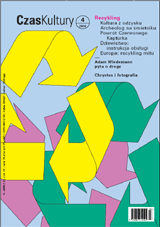Re-Grimm-owanie baśni. Kulturoterapia Angeli Carter
Re-Grimm-ing Fairy Tales. Angela Carter’s Culture Therapy
Author(s): Urszula ŚmietanaSubject(s): Cultural Essay, Political Essay, Societal Essay
Published by: Stowarzyszenie Czasu Kultury
Keywords: Grimm Brothers’ tales recycled by Angela Carter; Sexuality stemming from recycling literature; Reactivating the mother figure; A new scene with Little Red Riding Hood and the Wolf; fairy tales recycled;
Summary/Abstract: The exceptional power of a writer’s imagination makes it possible to bring to the surface new contents which have previously been buried under classical narration. The recycling of literature enhances our consciousness which has so far been filled with static models of interpretation. This is the context in which the British writer Angela Carter provides the reader with a new approach to the well-known tales of the Grimm Brothers. This approach is a literary adventure which opens the reader’s eyes to new horizons that significantly depart from the stereotypical cultural images. Urszula Śmietana notices Angela Carter’s innovative interpretation of sexuality. “According to Carter, sexuality is of fundamental importance to a person’s identity and interpersonal relations”. In this light femininity, represented by, for example, Sleeping Beauty, Cinderella and Little Red Riding Hood, regains its natural and clear character after being suppressed by patriarchal restrictions for so many years. This is also why Angela Carter skilfully transforms the mother figure and the animal character of the fairy tales. With full vitality the mother finally emerges from the literary and cultural non-existence into which she had been lost by the Grimm Brothers. The mother-daughter relationship plays a significant and dynamic role and this is well portrayed in the short story Ashputtle: or, The Mother's Ghost which shows that even the mother’s death does not break the maternal bond and the daughter’s life continues to be influenced by her parent. The animal character, on the other hand, “significantly extends the literary position of erotic elements in literature.” The famous scene featuring Little Red Riding Hood and the Wolf depicted by Carter in The Company of Wolves is not symbolic of “sexual tension”, but should be understood as “sexual initiation leading to mutual satisfaction, desire and even a communion of the opposite sexes.” In the re-Grimm-ed version Little Red Riding Hood does not resemble the innocent original; instead she longs for a passionate encounter with the Wolf in order to fully experience her newly discovered femininity. Her wild partner is symbolic of the culturally-concealed animal-like aspect of human sexuality and indicates Dionysian passion which breaks the Apollonian frameworks. The way Angela Carter’s recycles literature has a positive effect: the new version of the Grimm stories has the power to liberate the reader from the prevailing cultural infantilism of today.
Journal: Czas Kultury
- Issue Year: 2004
- Issue No: 04
- Page Range: 48-57
- Page Count: 10
- Language: Polish
- Content File-PDF

